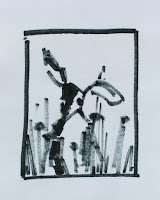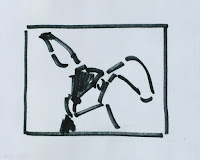or worse, we don't know HOW to use it.
 In class we have been painting animals using photo reference.
In class we have been painting animals using photo reference.So- how does doing a simple sketch help with complex material?
Our purpose is not to make tight realistic drawings before we go to paint BUT to use the sketch to make the most important design decisions before going forward.
 For the painting below, I had a photo of this crazy jackrabbit with lots of good detail.
For the painting below, I had a photo of this crazy jackrabbit with lots of good detail.It might be tempting to simply copy the photo reference as it is - but the best way to use reference is to redesign the material to suit YOUR purpose - not the photographer's.
I will sidestep the discussion about photo copyrights - too involved - but suffice to say, it is always better to use photo material as "reference" not to COPY it. Unless, of course, you took the photo yourself.
But when using ANY photo reference, design decisions must be made before touching the canvas with paint -
and this is where the disconnect happens.
While making these simple design decisions in your head seems like a good idea - it's like pointing your car in the right direction just hoping you will arrive at your destination.
I never cease to be amazed at how willing beginners are - to strike out onto the great white canvas with out a map or a clue. Maybe doing a sketch seems too basic?
Hmmm . . . . The PAINTING is our destination. And while I never have the whole piece figured out before hand - I can go forward with greater confidence if I have made the basic design decisions in a sketch.
The simple sketches at the top show 2 ways my painting could have gone. One is vertical, of a rabbit in the landscape,
the other is horizontal and more portrait like - both from the same photo reference material.
The face of the rabbit attracted me to the photo in the first place, - so it made sense to design the painting with that in mind and not commit to a lot of extra background landscape, etc.

My sketches are about 3 inches wide, and easy to do;
size does not matter but the information does. I can visualize and arrange the information to see how it best works before committing any paint to canvas.
Once I have done a few sketches it may become apparent that not every route is a good one, or I may end up choosing between 2 good ideas - No bad thing. When I am satisfied with the arrangement of my shapes I will use the sketch as a road map and the basis for what I want to do on the canvas.
Sometimes this takes only one sketch, sometimes 5.
Start with small, simple sketches and soon you will be adding more information to them and they will get better and will serve you better. You may even start to show them off as something you are proud of.